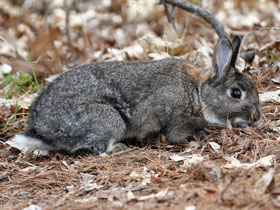The eastern cottontail (Sylvilagus floridanus)
The eastern cottontail (Sylvilagus floridanus) is a New World cottontail rabbit, a member of the family Leporidae. It is the most common rabbit species in North America.
Habitat, lifestyle and habits
Sylvilagus floridanus is distributed from eastern and central Canada and the United States to Colombia. This species inhabits a wide range of environments, from the tropics to regions with snowy winters. It inhabits both deserts and steppes, as well as forests and swamps, and is often found near human settlements. Sylvilagus floridanus is active mainly at night, occasionally in the early evening. The animal spends most of the daylight hours in a shallow hole or in dense thickets. In winter, when a thick layer of snow falls, Sylvilagus floridanus moves mainly under snow, digging a complex system of passages connecting feeding sites. Females of Sylvilagus floridanus are larger than males. The name "cottontail" comes from their short, round tails, which are white underneath. Their back is covered with grey, brown and reddish fur.
What it eats
Sylvilagus floridanus feeds mainly on grass, sometimes in winter supplementing its diet with tree bark, branches, seeds. Its digestive system has a special structure, adapted to the consumption of food in incredibly large volumes, so part of the digested food is excreted from the body in the form of soft greenish lumps and eaten again, the rest is excreted in the form of solid droppings. Rabbits are constantly chewing on something, leaving droppings right at the feeding site.
Social behaviour
Sylvilagus floridanus prefer to stay alone, sometimes forming small groups. They usually do not dig holes, but lie quietly all day in some small hole, hide in a tuft of tall grass or under snags. The breeding period of Sylvilagus floridanus lasts from February to September, with 4-5 litters per year. Males fight to establish a hierarchy, and the most successful ones get the opportunity to mate with females. The pregnant female digs a shallow burrow that is deeper at one end than the other. She lines the nest with grass and fur from her belly. A female hare's pregnancy lasts from 26 to 29 days and she bears 3-7 cubs. After giving birth to cubs, the female falls to the ground from the shallow edge and her cubs cluster from the warm deep edge and suckle milk. In the wild, Sylvilagus floridanus has a life expectancy of 2-3 years, but in captivity it can reach 10 years.
Predators
The eastern cottontail has to contend with many predators, both natural and introduced. Due to their often large populations in Eastern North America, they form a major component of several predators' diets. Major predators of eastern cottontail include domestic cats and dogs, foxes (Vulpes and Urocyon spp.), coyote (C. latrans), bobcat (Lynx rufus), weasels (Mustela spp.), raccoon (Procyon lotor), mink (M. vison), great horned owl (Bubo virginianus), barred owl (Strix varia), hawks (principally Buteo spp.), corvids (Corvus spp.), and snakes.
Predators that take nestlings include raccoon, badger (Taxidea taxus), skunks (Mephitis and Spilogale spp.), Crow, and Virginia opossum (Didelphis virginiana). In central Missouri, eastern cottontails comprised the majority of biomass in the diet of red-tailed hawks (Buteo jamaicensis) during the nesting season. In Pennsylvania, the chief predator of eastern cottontails is the great horned owl. In the Southwest cottontails including eastern cottontail comprise 7 to 25% of the diets of northern goshawk (Accipiter gentilis). In Texas, eastern cottontails are preyed on by coyotes more heavily in early spring and in fall than in summer or winter. In southwestern North Dakota, cottontails (both eastern and desert cottontail Sylvilagus auduboni) were major prey items in the diets of bobcats.
Juvenile eastern cottontails are rare in the diet of short-eared owls (Asio flammeus). Trace amounts of eastern cottontail remains have been detected in black bear (Ursus americanus) scat.
Classification
Recognized subspecies of Sylvilagus floridanus.
- North of Mexico:
- Sylvilagus floridanus alacer;
- Sylvilagus floridanus chapmani;
- Sylvilagus floridanus floridanus;
- Sylvilagus floridanus mallurus.
- Mexico and Central America:
- Sylvilagus floridanus aztecus;
- Sylvilagus floridanus connectens;
- Sylvilagus floridanus hondurensis;
- Sylvilagus floridanus macrocorpus;
- Sylvilagus floridanus orizabae;
- Sylvilagus floridanus yucatanicus;
- South of Isthmus of Panama:
- Sylvilagus floridanus avius;
- Sylvilagus floridanus cumanicus;
- Sylvilagus floridanus margaritae;
- Sylvilagus floridanus nigronuchalis;
- Sylvilagus floridanus orinoci;
- Sylvilagus floridanus purgatus;
- Sylvilagus floridanus superciliaris.










































